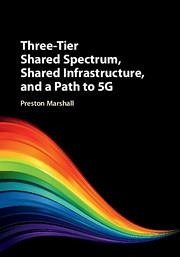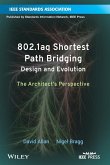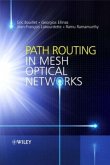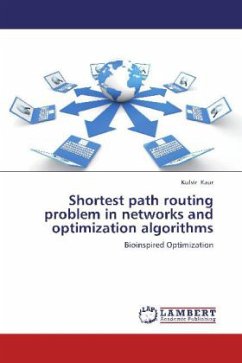Preston Marshall
Three-Tier Shared Spectrum, Shared Infrastructure, and a Path to 5g
Preston Marshall
Three-Tier Shared Spectrum, Shared Infrastructure, and a Path to 5g
- Gebundenes Buch
- Merkliste
- Auf die Merkliste
- Bewerten Bewerten
- Teilen
- Produkt teilen
- Produkterinnerung
- Produkterinnerung
Describes the technical requirements, policies, incentives, and challenges of implementing three-tier shared spectrum and its impact for 5G.
Andere Kunden interessierten sich auch für
![802.1aq Shortest Path Bridging Design and Evolution 802.1aq Shortest Path Bridging Design and Evolution]() David Allan802.1aq Shortest Path Bridging Design and Evolution84,99 €
David Allan802.1aq Shortest Path Bridging Design and Evolution84,99 €![Development of a Time-shared Analog Computer Development of a Time-shared Analog Computer]() Development of a Time-shared Analog Computer36,99 €
Development of a Time-shared Analog Computer36,99 €![Three-Dimensionl Int Circuit L Three-Dimensionl Int Circuit L]() A. C. HarterThree-Dimensionl Int Circuit L144,99 €
A. C. HarterThree-Dimensionl Int Circuit L144,99 €![Introduction to Mobile Network Engineering: Gsm, 3g-Wcdma, Lte and the Road to 5g Introduction to Mobile Network Engineering: Gsm, 3g-Wcdma, Lte and the Road to 5g]() Alexander KukushkinIntroduction to Mobile Network Engineering: Gsm, 3g-Wcdma, Lte and the Road to 5g142,99 €
Alexander KukushkinIntroduction to Mobile Network Engineering: Gsm, 3g-Wcdma, Lte and the Road to 5g142,99 €![Path Routing in Mesh Optical Networks Path Routing in Mesh Optical Networks]() Eric BouilletPath Routing in Mesh Optical Networks147,99 €
Eric BouilletPath Routing in Mesh Optical Networks147,99 €![Modeling Vegetation Effects for Path Loss Prediction in Urban Areas Modeling Vegetation Effects for Path Loss Prediction in Urban Areas]() Muhammad Umar KhanModeling Vegetation Effects for Path Loss Prediction in Urban Areas33,99 €
Muhammad Umar KhanModeling Vegetation Effects for Path Loss Prediction in Urban Areas33,99 €![Shortest path routing problem in networks and optimization algorithms Shortest path routing problem in networks and optimization algorithms]() Kulvir KaurShortest path routing problem in networks and optimization algorithms33,99 €
Kulvir KaurShortest path routing problem in networks and optimization algorithms33,99 €-
-
-
Describes the technical requirements, policies, incentives, and challenges of implementing three-tier shared spectrum and its impact for 5G.
Hinweis: Dieser Artikel kann nur an eine deutsche Lieferadresse ausgeliefert werden.
Hinweis: Dieser Artikel kann nur an eine deutsche Lieferadresse ausgeliefert werden.
Produktdetails
- Produktdetails
- Verlag: Cambridge University Press
- Seitenzahl: 344
- Erscheinungstermin: 11. September 2017
- Englisch
- Abmessung: 258mm x 181mm x 17mm
- Gewicht: 830g
- ISBN-13: 9781107196964
- ISBN-10: 1107196965
- Artikelnr.: 48529858
- Herstellerkennzeichnung
- Libri GmbH
- Europaallee 1
- 36244 Bad Hersfeld
- gpsr@libri.de
- Verlag: Cambridge University Press
- Seitenzahl: 344
- Erscheinungstermin: 11. September 2017
- Englisch
- Abmessung: 258mm x 181mm x 17mm
- Gewicht: 830g
- ISBN-13: 9781107196964
- ISBN-10: 1107196965
- Artikelnr.: 48529858
- Herstellerkennzeichnung
- Libri GmbH
- Europaallee 1
- 36244 Bad Hersfeld
- gpsr@libri.de
Preston Marshall led the Google and Alphabet Inc. efforts to establish the technical, commercial, and regulatory ecosystem to make three-tier spectrum a success in the USA. He was a major participant in the USA PCAST study that was the basis of the three-tier concept. He chairs the Wireless Innovation Forum Spectrum Sharing Committee, and is founding vice chair of the CBRS Alliance. Previously he was Deputy Director of the Information Sciences Institute (ISI) at the University of Southern California (USC), Research Professor at USC's Electrical Engineering Department, and Program Manager for wireless, cognitive radio, and networking programs at the US Defense Advanced Research Projects Agency (DARPA).
Part I. Spectrum Sharing Background: 1. Introduction to three tier spectrum sharing
2. Prior dynamic spectrum sharing regimes
Part II. Three Tier Dynamic Spectrum Models: 3. Key aspects of PCAST recommendations
4. US FCC CBRS regulations, and other international activity
Part III. Components of a Three Tier Architecture: 5. Three tier spectrum admission control systems
6. Admission control management of access point devices and their clients
7. Taxonomy of protection methods to be provided across and within tiers
Part IV. Protection Processes for Incumbents and Peers: 8. General process for database system operation
9. Protection of incumbent satellite operations
10. Protection to and from terrestrial access points and point-to-point networks
11. Protection to and from radar systems
12. Coexistence between unprotected peer devices
Part V. Example Use of Three Tier Spectrum: 13. Device and network interaction with the spectrum access system
14. CBRS SAS requirements
Part IV. Future Bands, Network Services, Business Models, and Technology: 15. Potential services and business models enabled by three tier spectrum
16. Candidate incumbent bands for three tier spectrum sharing
17. From shared spectrum, to shared infrastructure, to a new model of 5G
18. Future actions to deploy more three tier spectrum bands and nations
19. Alternatives to three tier operation
20. Conclusions and a look ahead
Part VII. Appendices: Appendix A. Terms and acronyms
Appendix B. Symbols
Appendix C. Opportunity cost model of spectrum utilization.
2. Prior dynamic spectrum sharing regimes
Part II. Three Tier Dynamic Spectrum Models: 3. Key aspects of PCAST recommendations
4. US FCC CBRS regulations, and other international activity
Part III. Components of a Three Tier Architecture: 5. Three tier spectrum admission control systems
6. Admission control management of access point devices and their clients
7. Taxonomy of protection methods to be provided across and within tiers
Part IV. Protection Processes for Incumbents and Peers: 8. General process for database system operation
9. Protection of incumbent satellite operations
10. Protection to and from terrestrial access points and point-to-point networks
11. Protection to and from radar systems
12. Coexistence between unprotected peer devices
Part V. Example Use of Three Tier Spectrum: 13. Device and network interaction with the spectrum access system
14. CBRS SAS requirements
Part IV. Future Bands, Network Services, Business Models, and Technology: 15. Potential services and business models enabled by three tier spectrum
16. Candidate incumbent bands for three tier spectrum sharing
17. From shared spectrum, to shared infrastructure, to a new model of 5G
18. Future actions to deploy more three tier spectrum bands and nations
19. Alternatives to three tier operation
20. Conclusions and a look ahead
Part VII. Appendices: Appendix A. Terms and acronyms
Appendix B. Symbols
Appendix C. Opportunity cost model of spectrum utilization.
Part I. Spectrum Sharing Background: 1. Introduction to three tier spectrum sharing
2. Prior dynamic spectrum sharing regimes
Part II. Three Tier Dynamic Spectrum Models: 3. Key aspects of PCAST recommendations
4. US FCC CBRS regulations, and other international activity
Part III. Components of a Three Tier Architecture: 5. Three tier spectrum admission control systems
6. Admission control management of access point devices and their clients
7. Taxonomy of protection methods to be provided across and within tiers
Part IV. Protection Processes for Incumbents and Peers: 8. General process for database system operation
9. Protection of incumbent satellite operations
10. Protection to and from terrestrial access points and point-to-point networks
11. Protection to and from radar systems
12. Coexistence between unprotected peer devices
Part V. Example Use of Three Tier Spectrum: 13. Device and network interaction with the spectrum access system
14. CBRS SAS requirements
Part IV. Future Bands, Network Services, Business Models, and Technology: 15. Potential services and business models enabled by three tier spectrum
16. Candidate incumbent bands for three tier spectrum sharing
17. From shared spectrum, to shared infrastructure, to a new model of 5G
18. Future actions to deploy more three tier spectrum bands and nations
19. Alternatives to three tier operation
20. Conclusions and a look ahead
Part VII. Appendices: Appendix A. Terms and acronyms
Appendix B. Symbols
Appendix C. Opportunity cost model of spectrum utilization.
2. Prior dynamic spectrum sharing regimes
Part II. Three Tier Dynamic Spectrum Models: 3. Key aspects of PCAST recommendations
4. US FCC CBRS regulations, and other international activity
Part III. Components of a Three Tier Architecture: 5. Three tier spectrum admission control systems
6. Admission control management of access point devices and their clients
7. Taxonomy of protection methods to be provided across and within tiers
Part IV. Protection Processes for Incumbents and Peers: 8. General process for database system operation
9. Protection of incumbent satellite operations
10. Protection to and from terrestrial access points and point-to-point networks
11. Protection to and from radar systems
12. Coexistence between unprotected peer devices
Part V. Example Use of Three Tier Spectrum: 13. Device and network interaction with the spectrum access system
14. CBRS SAS requirements
Part IV. Future Bands, Network Services, Business Models, and Technology: 15. Potential services and business models enabled by three tier spectrum
16. Candidate incumbent bands for three tier spectrum sharing
17. From shared spectrum, to shared infrastructure, to a new model of 5G
18. Future actions to deploy more three tier spectrum bands and nations
19. Alternatives to three tier operation
20. Conclusions and a look ahead
Part VII. Appendices: Appendix A. Terms and acronyms
Appendix B. Symbols
Appendix C. Opportunity cost model of spectrum utilization.








